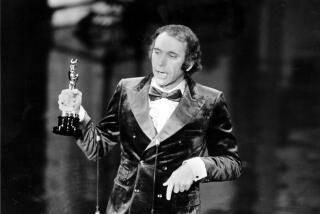Passionate Director Seems Forever Young
First comes the predictable shock: Stanley Kubrick, dead, the youthful creator felled with so much left to do. Then comes a different kind of shock: Stanley Kubrick was 70 years old.
For several interconnecting reasons, Stanley Kubrick will always be young in the film world’s eyes, always be the passionate baby auteur who made his first feature, the war-themed “Fear and Desire,” when he was 25 years old. This was back in 1953, when Sundance guru Robert Redford was still in high school, when the idea of young people making movies was a fantasy it would take decades to bring to reality.
But Kubrick, who was a staff photographer for Look magazine when he was 17, had always been a young man in a hurry. If his first two features were uncertain, his third, a racetrack crime thriller called “The Killing,” crackled with tension and despair.
By the time the 1960s flowered and the French New Wave turned the search for personal filmmakers into a categorical imperative, American critics eager for a hot young director to champion turned around and discovered the intense and bearded Kubrick in their midst.
Between 1957 and 1971, Kubrick ran off a string of six impressive films, intelligent, superbly crafted projects touched with the black humor and pessimism about the human condition that characterized his work. Taken in toto, they made him a role model for directors yearning to work smartly and independently within the studio system.
First came “Paths of Glory,” still considered a classic among antiwar films. Next was “Spartacus,” more thoughtful than big-budget Hollywood epics usually were. That was followed by “Lolita,” a sardonic take on the Vladimir Nabokov novel that has dated not at all, the devastating satire “Dr. Strangelove; or, How I Learned to Stop Worrying and Love the Bomb,” and two films whose intensity and prescience made them landmarks in their genres: the science fiction “2001: A Space Odyssey” and the grandfather of teens-run-amok dystopian visions, “A Clockwork Orange.”
Though it was not much noticed at the time, in the long run a decision Kubrick made in 1961 had the biggest influence on his career. Hungry for even more of the kind of independence that today’s beginning filmmakers take for granted, Kubrick moved to England, setting up a home and eventually a studio in rural Buckinghamshire.
One reason we think of Kubrick as forever young is that by most measures his best work was finished before he was 45. As his time in England lengthened his films became fewer, farther apart and less satisfying.
Always technically gifted and infatuated with the mechanics of filmmaking, Kubrick became increasingly obsessive, worrying about physical details but, some critics claimed, losing touch with film’s human dimension. As critic David Thomson said in reference to “2001,” “Kubrick treats computers in the way Sternberg did Dietrich.”
So 1975’s “Barry Lyndon,” Kubrick’s first film after “Clockwork Orange,” was more memorable for how the director managed to shoot scenes lit only by candlelight than for anything dramatic. In the 20-plus years since then, only two features, 1980’s “The Shining” and 1987’s “Full Metal Jacket,” have been released under Kubrick’s name.
As his working pace slowed, Kubrick became increasingly reclusive, so much so that an impostor was able to dine out in London for some time, pretending to all who would listen that he was the great director in the flesh.
Another reason we think of the filmmaker as young and dynamic is that Kubrick strenuously resisted the culture of personality that defines our time. He so completely avoided interviews and photographs that we have not seen him age in the public prints; we have no images of him as a graybeard sage to contradict the picture of him as passionate and committed.
Yet just because he was removed did not mean that Kubrick had mellowed. When Warner Bros. was putting together a touring show to commemorate its 75th anniversary, he burned up the overseas phone lines with specific suggestions about which of his films he wanted shown and how. And when a visiting journalist asked a London film editor a few years back if Kubrick’s latest project, “Eyes Wide Shut,” was in fact a reality, the answer was unequivocal: “Absolutely. They’ve already started firing people.”
That film, starring Nicole Kidman and Tom Cruise and now officially Kubrick’s last, was reportedly just finished and finally shown to eager Warner Bros. executives. Working with a skeleton crew, a tactic that ensured his control and stretched his budget, Kubrick, ever the driven perfectionist, tied up two of Hollywood’s biggest stars for more than a year of shooting in an effort to get things exactly right.
With “Eyes Wide Shut” due out later this year, everyone is hoping that this uncompromising man has left us one last gem to savor.
More to Read
Only good movies
Get the Indie Focus newsletter, Mark Olsen's weekly guide to the world of cinema.
You may occasionally receive promotional content from the Los Angeles Times.











